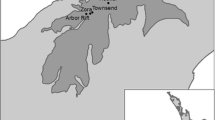Abstract
Large-scale natural disturbances, such as hurricanes, have profound effects on populations, either directly by causing mortality, or indirectly by altering ecological conditions or the quantity, quality, and spatial distribution of resources. In the last 20 years, two major disturbances, Hurricane Hugo in 1989 and Hurricane Georges in 1998, struck the Luquillo Mountains of Puerto Rico, providing an unique opportunity to understand the long-term effects of recurrent disturbances on the abundance of species. Nenia tridens is one of the most abundant and pervasive terrestrial gastropods in the Luquillo Mountains. Estimates of yearly abundance of N. tridens from 40 sites on the Luquillo Forest Dynamics Plot from 1991 to 2007 facilitate the development of a spatiotemporal model with intervention effects on the mean abundance over time in response to each hurricane. Intervention effects characteristically decay over time, similar to those in a time series analysis. Model parameters were estimated in a Bayesian framework. Model comparison and diagnostics suggest that our intervention model provides a plausible description of hurricanes effects on the abundances of N. tridens and may be useful for studying long-term spatiotemporal dynamics from the perspective of disturbance and succession.
Similar content being viewed by others
References
Besag, J., and Kooperberg, C. (1995), “On Conditional and Intrinsic Autoregressions,” Biometrika, 82, 733–746.
Bloch, C. P., and Willig, M. R. (2006), “Context-Dependence of Long-Term Responses of Terrestrial Gastropod Populations to Large-Scale Disturbance,” Journal of Tropical Ecology, 22, 111–122.
Box, G. E. P., and Tiao, G. C. (1975), “Intervention Analysis with Applications to Economic and Environmental Problems,” Journal of the American Statistical Association, 70, 70–79.
Brown, S., Lug, A. E., Silander, S., and Liegel, L. (1983), “Research History and Opportunities in the Luquillo Experimental Forest,” General Technical Report SO-44, United States Department of Agriculture, Forest Service, Southern Forest Experiment Station, New Orleans, Louisiana, USA.
Clement, L., and Thas, O. (2007), “Estimating and Modeling Spatio-Temporal Correlation Structures for River Monitoring Networks,” Journal of Agricultural, Biological, and Environmental Statistics, 12, 161–176.
Cryer, J. D., and Chan, K.-S. (2008), Time Series Analysis with Applications in R (2nd ed.), Berlin: Springer.
Dey, D. K., Chen, M. H., and Chang, H. (1997), “Bayesian Approach for Nonlinear Random Effects Models,” Biometrics, 53, 1239–1252.
Ewel, J. J., and Whitmore, J. L. (1973), “The Ecological Life Zones of Puerto Rico and the United States Virgin Islands,” Forest Service Research Papers ITF-18.
Geisser, S. (1993), Predictive Inference: An Introduction, London: Chapman & Hall.
Geisser, S., and Eddy, W. F. (1979), “A Predictive Approach to Model Selection (Corr: V75 P765),” Journal of the American Statistical Association, 74, 153–160.
Gelfand, A. E., and Dey, D. K. (1994), “Bayesian Model Choice: Asymptotics and Exact Calculations,” Journal of the Royal Statistical Society, Series B: Methodological, 56, 501–514.
Gelfand, A. E., Dey, D. K., and Chang, H. (1992), “Model Determination Using Predictive Distributions, with Implementation Via Sampling-based Methods (Disc: P160-167),” in Bayesian Statistics 4. Proceedings of the Fourth Valencia International Meeting, eds. J. M. Bernardo, J. O. Berger, A. P. Dawid, and A. F. M. Smith, Oxford: Clarendon Press/Oxford University Press, pp. 147–159.
Geweke, J. (1992), “Evaluating the Accuracy of Sampling-based Approaches to the Calculation of Posterior Moments (Disc: P189-193),” in Bayesian Statistics 4. Proceedings of the Fourth Valencia International Meeting, eds. J. M. Bernardo, J. O. Berger, A. P. Dawid, and A. F. M. Smith, Oxford: Clarendon Press/Oxford University Press, pp. 169–188.
Gosz, J. R. (1999), “Ecology Challenged? Who? Why? Where Is This Headed?,” Ecosystems, 2, 475–481.
Hodges, J. S., Carlin, B. P., and Fan, Q. (2003), “On the precision of the conditional autoregressive prior in spatial models,” Biometrics, 59, 317–322.
Kass, E. R., and Raftery, E. A. (1995), “Bayes Factor,” Journal of the American Statistical Association, 90, 773–795.
Lugo, A. E., and Frangi, J. L. (2003), “Changes in Necromass and Nutrients on the Forest Floor of a Palm Floodplain Forest in the Luquillo Mountains of Puerto Rico,” Caribbean Journal of Science, 39, 265–272.
McDowall, D., McCleary, R., Meidinger, E. E., and Hay, R. A. J. (1980), Interrupted Time Series Analysis, Thousand Oaks: Sage.
Moran, P. A. P. (1950), “Notes on Continuous Stochastic Phenomena,” Biometrika, 37, 17–33.
Ostertag, R., Scatena, F. N., and Silver, W. L. (2003), “Forest Floor Decomposition Following Hurricane Litter Inputs in Several Puerto Rican Forests,” Ecosystems, 6, 261–273.
Rasmussen, P. W., Heisey, D. M., Nordheim, E. V., and Frost, T. M. (1993), “Time-Series Intervention Analysis: Unreplicated Large-Scale Experiments,” in Design and Analysis of Ecological Experiments, eds. S. M. Scheiner, and J. Gurevitch, London: Chapman & Hall, pp. 138–158.
Scatena, F. N., and Larsen, M. C. (1991), “Physical Aspects of Hurricane Hugo in Puerto Rico,” Biotropica, 23, 317–323.
Scheiner, S. M., and Willig, M. R. (2008), “A General Theory of Ecology,” Theoretical Ecology, 1, 21–28.
Willig, M. R., Secrest, M. F., Cox, S. B., Camilo, G. R., Cary, J. F., Alvarez, J., and Gannon, M. R. (1998), “Long-term Monitoring of Snails in the Luquillo Experimental Forest of Puerto Rico: Heterogeneity, Scale, Disturbance, and Recovery,” pp. 293–322.
Willig, M. R., Bloch, C. P., Brokaw, N., Higgins, C., Thompson, J., and Zimmermann, C. R. (2007), “Cross-Scale Responses of Biodiversity to Hurricane and Anthropogenic Disturbance in a Tropical Forest,” Ecosystems, 10, 824–838.
Zimmerman, J. K., Willig, M. R., Walker, L. R., and Silver, W. L. (1996), “Introduction: Disturbance and Caribbean Ecosystems,” Biotropica, 28, 414–423.
Author information
Authors and Affiliations
Corresponding author
Rights and permissions
About this article
Cite this article
Prates, M.O., Dey, D.K., Willig, M.R. et al. Intervention Analysis of Hurricane Effects on Snail Abundance in a Tropical Forest Using Long-Term Spatiotemporal Data. JABES 16, 142–156 (2011). https://doi.org/10.1007/s13253-010-0039-1
Accepted:
Published:
Issue Date:
DOI: https://doi.org/10.1007/s13253-010-0039-1




